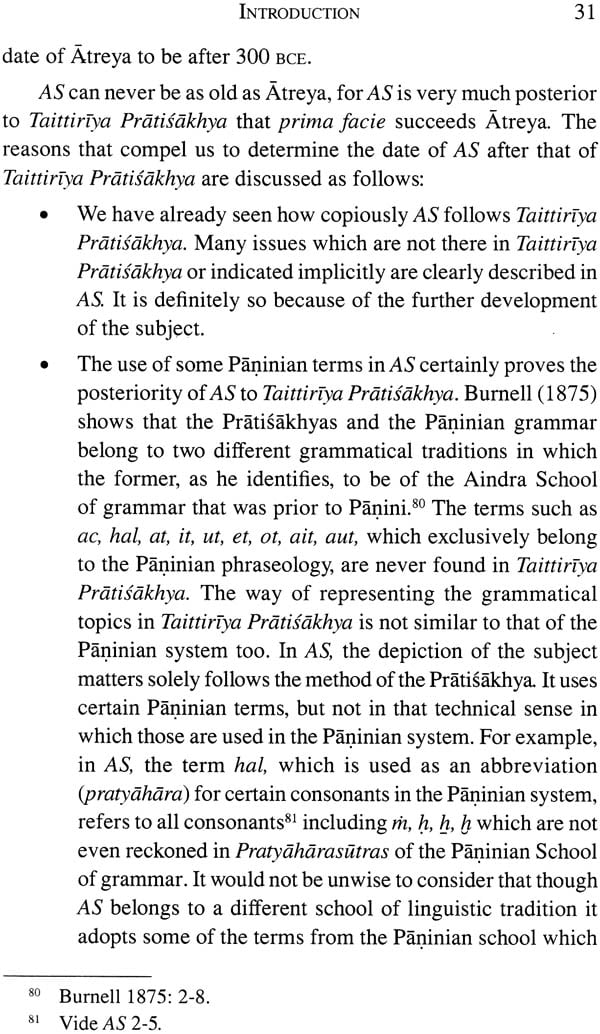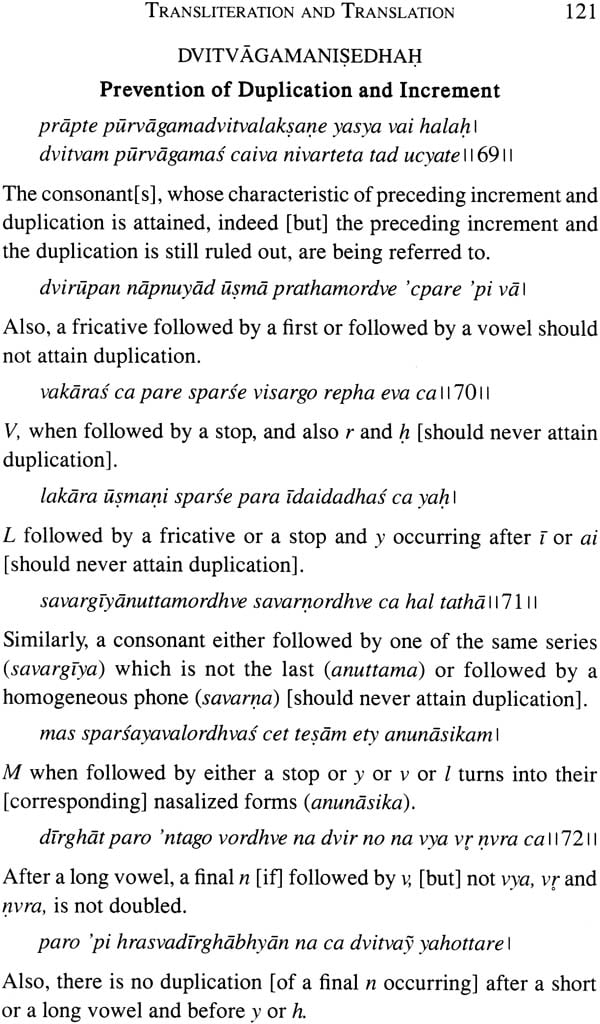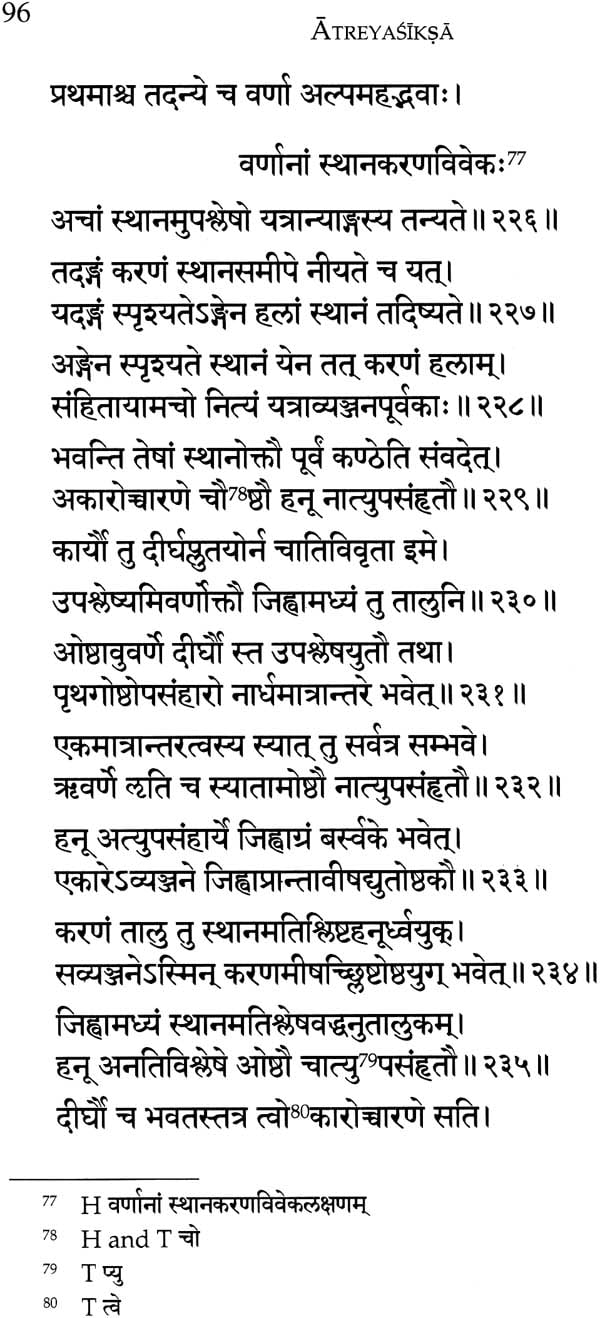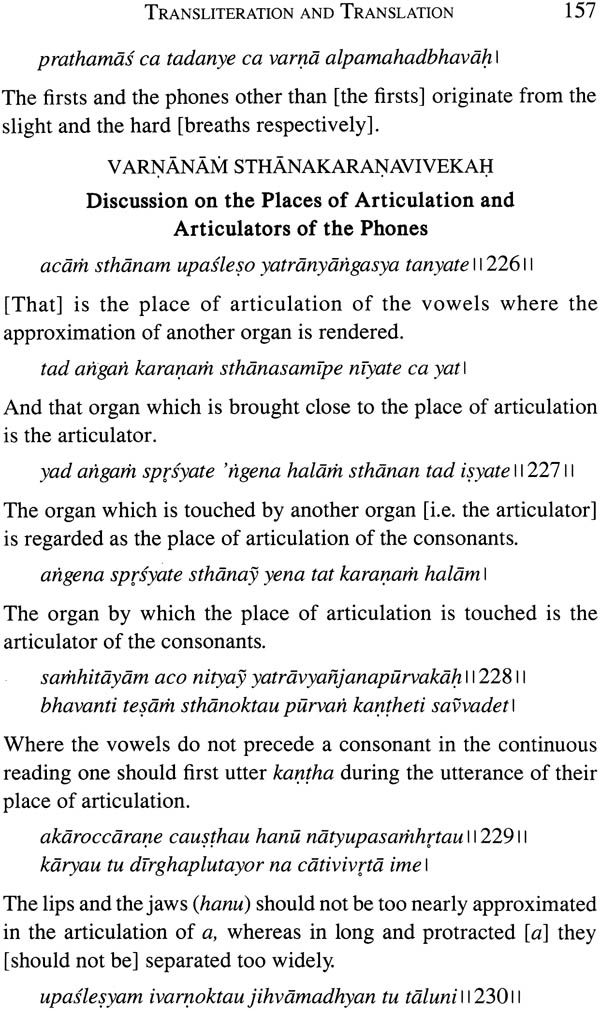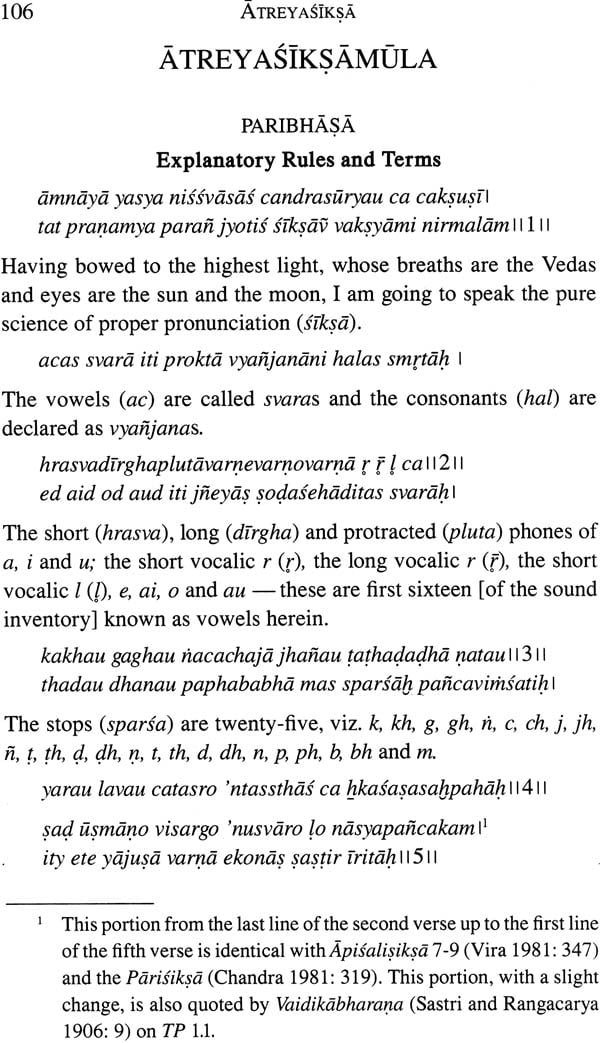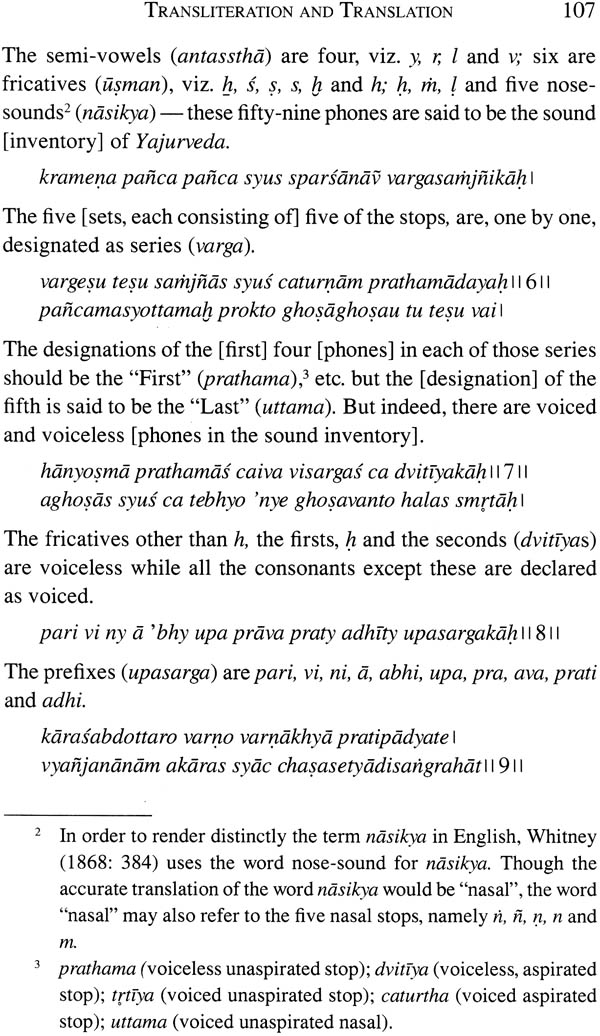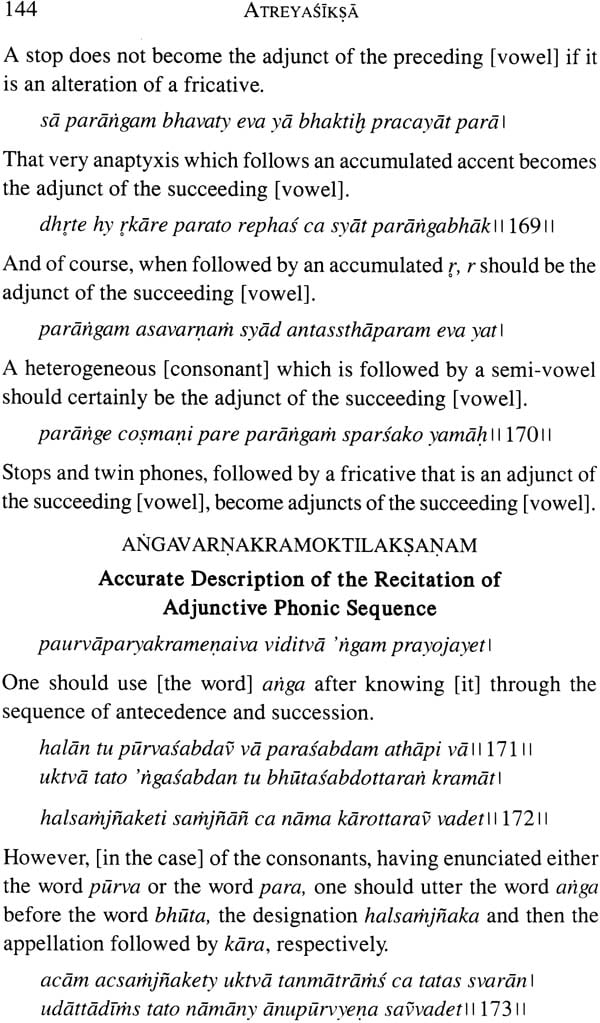
Atreyasiksa (A Siksa of The Taittriya School)
Book Specification
| Item Code: | NAK744 |
| Author: | Deepro Chakraborty |
| Publisher: | D. K. Printworld Pvt. Ltd. |
| Language: | Sanskrit Text With Trasnliteration and English Translation |
| Edition: | 2015 |
| ISBN: | 9788124608234 |
| Pages: | 279 |
| Cover: | Hardcover |
| Other Details | 9.0 inch X 6.0 inch |
| Weight | 580 gm |
Book Description
Atreyasiksa is one of the Siksa texts of the Krsna- Yajurveda, Taittiriya school. This text has been critically edited and translated consulting two palm-leaf manuscripts which are currently the only discovered manuscripts of this text in public libraries. Siksa texts deal with phonetics and phonology of the Vedas and the method of proper pronunciation and recitation. The Atreyasiksa is well-structured in terms of arranging its topics of discussion.
When compared to the other Siksas of the Taittiriya school, the Atreyasiksa, in keeping its focus on the discussion on the different methods of Vedic recitation, namely, word- reading (padapatha), sequential reading (kramapatha), tangled reading (jatapatha) and the five varieties of the reading of the phonic sequences (varnakramas), holds a unique position in the corpus of the Siksa literature. A close reading of the text shows that the main aim of the text is to explain the practical aspects of the different ways of Vedic recitation, in whose connection it describes the theoretical elements of Siksa too.
The book, therefore, serves as a practical guidebook to Vedic reciters who recite the above-mentioned readings of the Taittiriya Krsna- Yajurveda along with the continuous reading. While describing the methods of recitation, the Atreyasiksa gives enough emphasis on the theoretical nuances. The phonological rules, most of which areexpressed in the Taittiriya Pratisakhya, are also illustrated in this text. This book consists of a detailed introduction, the critically edited text in Devanagari script, its Roman transliteration and an authentic English translation.
For Deepro Chakraborty manuscriptology is a favourite scholarly hunt. With an ardent desire of producing annotated editions of ancient and medieval Indian manuscripts, written in Sanskrit, which are yet to be done so, he has taken up Atreyasiksa as his first venture.
Deepro Chakraborty studied Sanskrit along with Linguistics and Ancient Indian History from Sanskrit College, Kolkata. He secured a first class and the highest marks in the University of Calcutta at the graduation level in 2009. He took his Masters from the Special Centre for Sanskrit Studies, Jawaharlal Nehru University, New Delhi, where he secured the highest marks among all the students (MA & M.Sc.) in 2011 earning central government's Certificate of Appreciation. He did his M. Phil., again with a first class, from JNU. At present, he is an assistant professor of Sanskrit at Gurudas College, Kolkata.
One of the most sophisticated intellectual traditions of ancient India has been its systematic study of sounds. Siksa or the school of phonetics-phonology was a critical necessity of India's oral tradition than a pretentious intellectual exercise. No wonder that four out of the six disciplines of study (Vedangas) in the Vedic tradition dealt with linguistic analysis - Nirukta (etymology), Chandas (metrics), Siksa (phonetics-phonology), Vyakarana (grammar) - with Siksa being the foremost among them. Atreyasiksa is a mature text of the Taittiriya school of the Krsna- Yajurveda and presents a set of instructions primarily dealing with precise pronunciation and recitation methods of the Vedic hymns. Unlike some other texts of the Siksa-Pratisakhya genre, Atreyasiksa deals with a wide range of topics including the core areas like enumeration, general description and properties of sounds, their place and manner of articulation, patha techniques and sound combination rules. The text also discusses some general ancillary concepts and of course the merits of correct pronunciation/recitation and demerits if not done the prescribed way.
The manuscripts of the text were not easy to find. With pains- taking effort, Deepro Chakraborty - the editor of this volume - was able to locate one of them in the Staats- und Universitatsbibliothek, Hamburg, Germany and the other in Oriental Research Institute and Manuscripts Library, Sri Venkateswara University, Tirupati. While some earlier efforts to edit Atreyasiksa could not succeed completely, Deepro was able to reach his efforts to a meaningful conclusion. The book will be extremely useful for any authentic study of the Vedic texts in general and of the Taittiriya school in particular. The students of linguistics and Vyakarana alike will benefit from this critical edition and translation. An empirical study of some nuances of pronunciation typical to this school of Vedic tradition may be the next step for research students of Sanskrit phonetics and phonology.
I congratulate Deepro Chakraborty for undertaking this serious academic exercise with sincerity and commitment for his M. Phil. research and making sure that the work reaches conclusion in the short span of two years. I offer my deep appreciation to the publisher for agreeing to publish this important text of India's long, continuous and unbroken intellectual tradition. Finally I thank Special Centre for Sanskrit Studies, Jawaharlal Nehru University (JNU) for facilitating this research and to the library of JNU for supporting the acquisition of the manuscript from the Hamburg Library, Germany.
The field of Sanskrit phonetics is always my favourite interest. However, when I searched for the primary works in this area I discovered that a huge number of Sanskrit phonetic texts, which mainly consists of the Siksa and the commentaries of Siksa and Pratisakhya texts, are still unexplored, i.e. they have not undergone any proper edition or translation. These texts are important not only because they depict the proper method of pronouncing the Vedas but also because they are actually the documents of early Indian contemplations on phonetics and phonology. Therefore, these texts, which comprise a number of significant phonetic thoughts, are very important from the perspective of history of linguistics. A deep analytical study of these texts can throw light on the chronological development of linguistics in early India, a hitherto comparatively unexplored area of knowledge. The fact is that we know very little about the historical development of Sanskrit literature on phonetics whereas we know much more about grammar and its gradual growth. Scarcity of printed texts is the chief obstacle for linguistic and historical research in this field. The printed editions, too, require translation and explanation in order to be accessible to those researchers who are not skilled in handling Sanskrit texts. There is a need for critical editions, translations and explications of Siksa literature for facilitating further research.
As for Atreyasiksa it is a handbook for the Taittiriya Vedic reciters who recite the phonic sequences along with samhita, pada, krama and jata. However, this text does not include methods of other artificial readings such as ghana, sikhd, dhvaja, etc. As a Siksa text, Atreyasiksa contextually describes many phonetic laws, most of which can be traced to Taittiriya Pratisakhya. Also, the way in which the subject matter of Atreyasiksa is arranged appears to be very similar to Parisiksa. Therefore, Taittiriya Pratisakhya and its commentaries, especially vaidikabharana and Tribhasyaratna, and Parisiksa and its commentary Yajusabhasana facilitated the interpretation of Atreyasiksa verses. I sometimes consulted Vyasasiksa and Sarvasammatasiksa along with their commentaries, Vedataijasa and Sarvasammatasiksa- Vivarana respectively.
Also, Atreyasiksa contains a versified content list called Atreyasiksa-Karika, which is rare not only in the Sik~a literature but also in the whole corpus of the Sanskrit texts, adds another unique feature to the text in focus. Additionally, some new topics which are not usually discussed in other texts of the same category are found in Atreyasiksa. The sections dealing with the dos and don'ts during Vedic recitation, the classification of sabda, the inner functions of the human body, the activities of the five vital airs and the detailed account of differing fruits of Vedic studies are unique themes which are rarely found in other texts of the same genre. I drew upon the expertise of and the scrutiny and proper explication by scholars who are well-versed in the yogic knowledge for interpretation of the section that deal with the inner activities of the human body and the five vital airs.
I took the project of critically editing and translating the text Atreyasiksa as part of my M. Phil. dissertation that was submitted to the Special Centre for Sanskrit Studies, Jawaharlal Nehru University (JNU) in August 2013 under the supervision of Dr Girish Nath Jha. My first and foremost thanks go to him for his sincere and meticulous guidance. His observations and corrections enriched my text and clarified my ideas. It is he who actually suggested me to work on this particular text and encouraged me to publish this work. His is a great contribution behind the publication of this work.
I thank Prof. Shashiprabha Kumar who sincerely helped me in every respect as a chairperson of Special Centre for Sanskrit Studies, JNU My indebtedness to her is beyond expresssions.
I express my gratitude to Dr Srinivasa Varakhedi, Dean, Shastra Faculty, Karnataka Samskrit University, Bangalore; Dr Dipak Bhattacharya, Retired Professor, Department of Sanskrit, Pali and Prakrit, Visva Bharati, Shantiniketan; Dr Nabanarayan Bandyopadhyay, Professor and Director, School of Vedic Studies, Rabindra Bharati University, Kolkata; Dr Dilip Kumar Rana, Director, Chinmaya International Foundation Shodha Sansthan, Adisankaranilayam, Ernakulam; Dr Nirmala R. Kulkarni, Professor, Centre of Advanced Study in Sanskrit, University of Pune, Pune; and Dr Siddharth Y. Wakankar, Professor, Centre for Ancient History & Culture, Jain University, Bangalore, who helped me at the initial stage of my project.
I sincerely thank the following libraries for providing me resources for my research - Staats- und Universitatsbibliothek, Ham- burg, Germany; Punjab University Library, Lahore, Punjab; Oriental Research Institute and Manuscripts Library, Sri Venkateswara University, Tirupati, Andhra Pradesh; Oriental Research Institute and Manuscripts Library, University of Kerala, Kariavattom, Kerala; D.A.Y. College, Chandigarh; Vishveshvaranand Vedic Research Institute, Hoshiarpur, Punjab; Government Oriental Manuscript Library, Chennai, Tamil Nadu and Kalanidhi, Indira Gandhi National Centre for Arts, New Delhi. I also thank University Grants Commission, New Delhi for granting me fellowship.
My indebtedness goes to Mr Hans-Walter Stork, Manuscript Librarian, Western and Non-European Manuscripts, Staats- und Universitatsbibliothek; Mr Hamid Ali, Senior Librarian (Manuscripts), Punjab University Library; Mr Narasimha, Library staff, ORI & ML, Sri Venkateswara University; Mr Shaji Lal, Library staff, ORI & ML, University of Kerala; Mrs Deepti Madaan, Librarian, D.A. Y. College; Mr Peter Freund, Tape Librarian, Maharishi University of Management, Fairfield, Iowa, USA; Ranjana Ray, Librarian, Kalanidhi, IGNCA; Ramesh Chandra Gaur, Librarian, Central Library, JNU; Dr Shim Jaekwan, Research Professor, Sangji University, Wonju, South Korea; Dominik Wujastyk, Department of South Asian, Tibetan and Buddhist Studies, University of Vienna, Vienna, Austria and N.Y. Ramachandran, Director, ACIP Sanskrit Project, Kerala Centre, Palghat, Kerala who helped me by providing manuscripts and other information essential to my project.
Besides, I gratefully acknowledge Peter Scharf, S. Jagannatha, Shriramana Sharma, Viroopaksha Jaddipal, P. Ramanujan, Anjalika Mukhopadhyay and Mridula Saha for their sincere response to my queries occurring at different times of my editing the text. Special mention must be made of Dr Chandrashekhar Ramaswamy who helped me in deciphering a Telugu manuscript and provided a number of references.
A host of friends connected with my project must be remembered with gratitude. I am greatly indebted to Varsha Patel for her enormous help. Shilpi Sarkar, Sujoy Sarkar too helped me in various ways. I am also grateful to Meera Vishvanathan and Aniruddha Kar for their help. I had fruitful discussions on my topic with Diwakar Mishra, Jay Saha, Rishiraj Pathak and Shweta Deshpande. Seniors and friends who also helped in different ways are Manji Bhadra, Biplob Sardar, Parthasarathi Sil, Archana Tiwari, Devalina Saikia, Jnanesh Marathe, Arjun Kashyap, A. Eswaran and Pallavi Pal.
Lastly, I express my indebtedness to my family, especially my mother Susmita Basu, sister Sutanoya Chakraborty, father Dipankar Chakraborty, my closest friend Anirban Das and another well-wisher Arup Lodh for their assistance and for being constant sources of inspiration. Without the help of all the above-mentioned people I could not have done this work as I have done it.
This work is concerned with producing an edition of Atreyasiksa, a Siksa work associated with the Taittiriya School of the Kr~1Ja- Yajurveda. Atreyaslk~ii is an excellent work, for such a comprehensive, well-structured, clear and complete text is very rare in the whole body of the Siksa literature. It is, however, not widely acknowledged by the commentators on the Siksa and Pratisakhya literature and no commentary of this text has yet been found. It is also true that the text which clearly describes the topics in a very simple and lucid language would hardly require a commentary.
This book is divided into three chapters followed by five appendices. The first chapter is the introduction which provides an elementary notion about the Siksa literature, a survey of all the available literature in this field, an account of the various aspects of the Atreyasiksa, a detailed description of the two MSS which are used for this edition and the methodology adopted for this research. The second chapter presents the critically edited text along with its variant readings. The third chapter provides a Roman transcription using IAST and the English translation of the text.
Verse index, the glossary of important terms used in the main text and English renderings of some important Sanskrit terms are provided in the appendices. In order to acquaint the reader with the orthography of the original MSS the text of Atreyasiksa in Grantha script with the spellings as found in the MSS is appended with this book. As Atreyasiksa closely resembles the Taittiriya Pratisakhya in terms of most of its subject matters, an appendix of the comparative references to AS and Taiuiriya Prdtisakhya is also provided in order to facilitate further research.
Siksa
Siksa constitutes one of the six auxiliary sciences of the Vedas (Vedanga)' and flourished as a major discipline in early India. Although etymologically the word Siksa means "teaching", "training" or "learning", technically, it refers to the specific branch of knowledge that deals with proper articulation and pronunciation. While some of these disciplines, although originating as a Vedanga, have received independent status (allowing them to incorporate even those topics which are not directly related to the Vedas), in the case of the Siksas (as we find them today), it appears that such development did not take place. In other words, general topics of phonetics and phonology irrespective of the Vedas could not become the subject matter of the discipline Siksa. Almost all Siksa texts are associated with one or the other Vedic schools.
| Foreword | vii | |
| Preface | ix | |
| Transliteration Key | xiv | |
| Abbreviations | xv | |
| Chapter I | Introduction | 1 |
| Siksa | 2-9 | |
| The Atreyasiksa | 11-38 | |
| Description of the Manuscripts | 42-54 | |
| Methodology | 55-68 | |
| Chapter II | Critically Edited Text | 71-102 |
| Chapter III | Transliteration and Translation | 103-171 |
| Appendix I | Index of Half-Verses | 173 |
| Appendix II | Index I: References Used in This Book | 183 |
| Index II: Important Terms Occuring in Atreyasiksamala | 187 | |
| Appendix III | English Equivalents of Some Important Sanskrit Terms Used in Atreyasiksamala | 199 |
| Appendix IV: | The Text in Grantha Script with the Spellings Found in the Manuscripts | 206 |
| Appendix V: | The Atreyasiksamala and Taittiriya Pratisakhya: Comparative References | 240 |
| Bibliography | 248 |

